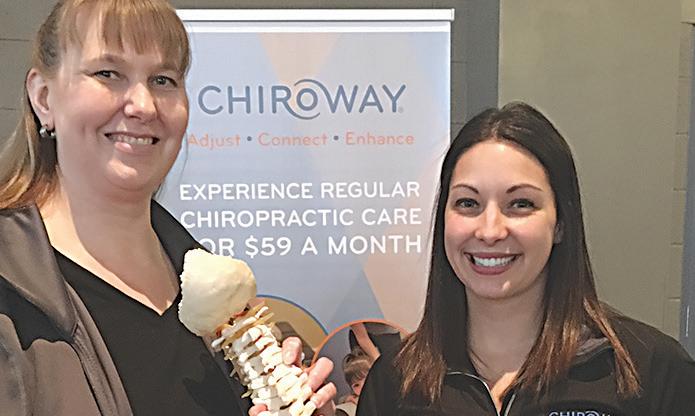Millions of dollars in scholarships available in Northland




Millions of dollars in scholarships available in Northland



Moms & Dads Today is looking at education from many points of view this issue. We look at how scholarships help pay for college, how schools work to close the achievement gap, and how parents can prepare their adolescent children to move out and move on. Of course, education happens at home, too, and not just for children. Read about how parents find support through social media, and how gardening with children is filled with learning. And as always, we hope you’ll take a day to travel with your kids, cook together, or make a craft. And keep an eye open for monarch butterflies; you’ll see some of them about, too!

Enjoy the season!
Olson

David Ballard; Stephanie Bartek; Andrea Novel Buck; Andrea Busche; Beverly Godfrey; Liz Carey; Bob King; Steve Kuchera; Derek Montgomery; Kathleen Murphy; Mary Rasch; Kelsey Roseth; Alison Stucke; Ali Wade; Mary Welle; Connie Wirta; Naomi Yeager


Add your event to our calendar at Duluth.com



Concerned about your children being able to afford college?
According to the College Board, the average cost of tuition and fees for the 2017–18 school year was $34,740 at private colleges, $9,970 for state residents at public colleges, and $25,620 for out-of-state residents at public colleges. That’s for a single year.
In addition to starting a 529 or other college savings account, what can parents do? Encourage your high school senior to apply for scholarships.
Noah Squires did. The scholarships he received fully paid his first two years’ tuition at Itasca Community College. They continue to help fund his $23,000-a-year tuition at Michigan Technical University, where he is in his third year of study toward a bachelor’s degree in mechanical engineering. Over the four years, he will have received well over $30,000 from a variety of renewable scholarships and one-time awards.
As a result, Squires hasn’t had to work during the school year. He has been able to concentrate on his studies, pursue opportunities like participating in the Society of Automotive Engineers’ “Clean Snowmobile Challenge” to re-engineer a snowmobile with decreased emissions and noise and increased fuel efficiency, and land paid internships in his field. Last summer, he worked at Polaris on a snowmobile powertrain development team. This summer through next, he will work at Bobcat on a new product development team for skid loaders.
In the Northland, roughly $4.3 million in scholarship opportunities are available annually.
“That’s a lot of money,” said Patty Salo Downs, executive director of the Alworth Memorial Fund in Duluth. In its 70th year this spring, the fund awarded its 5,000th scholarship and surpassed a milestone of $50 million in awards.

“And, it’s not a fixed list,” said David Hammer, scholarship officer at the Duluth Superior Area Community Foundation, who oversees the awarding of 65 different scholarship funds. “It’s growing all the time.”
• $10,000 Marguerite Gilmore scholarships, renewable for four years, for Northland area high school students who graduate in the upper 8 percent of their classes.
• $5,000 Marshall H. and Nellie Alworth scholarships, renewable for four years, for Northland area students with a grade point average of 3.5 or higher studying in the science, technology, engineering and mathematics fields.


• $5,000 Robert B. and Sophia Whiteside scholarships, renewable for four years, for graduating seniors from Duluth public and private high schools in the top 10 percent of their classes.
• $3,000 Marie Saltwick scholarships and $3,000 Armond H. Hauge scholarships, renewable for four years, for graduating seniors with a GPA of 2.8 or higher from Denfeld High School.
“The beauty of these scholarships is, we have kids able to graduate debt-free,” Salo Downs said.
Lori Huska, scholarship administrator for Northland Scholarship Services, which oversees 13 different scholarship funds for Denfeld High School students, has seen local scholarship dollars left on the table because students didn’t apply or didn’t take the time to complete their applications.

“It’s amazing to me,” Huska said.

“Some kids self-select themselves out of the running,” Salo Downs said, thinking they need to be at the top of their class.
That isn’t necessarily so. Some scholarships require only a 2.5 GPA. Some are for late bloomers, students who for some unfortunate circumstance in their lives, haven’t realized their potential in high school. Some are for children or grandchildren of a specific company’s employees. Some are targeted to a specific college, field of study or trade. A couple go to students with children.


Squires took to heart the advice of his Northwoods High School guidance counselor: “Don’t count yourself out of a scholarship before you apply; sometimes your chances are pretty good.” He turned out to be a better candidate than he thought, he said, securing several scholarships. They included a $5,000 renewable Alworth scholarship, for which his high school biology teacher recommended him. “It was pretty awesome,” he said.

Applications for scholarships from the Alworth Memorial Fund, Duluth Superior Area Community Foundation and Northland Scholarship Services can be made online. Some require an additional essay, which might take a student a few hours to complete. Some require an interview. Most are due in midJanuary, but students can start applying in the fall.
Compare that to how many hours it takes to earn $20,000 at a minimum-wage job. The return is huge, Salo Downs said. “Help your kids understand that putting these applications in is well worth their time.”
Salo Downs has counseled many a young person to consider scholarships as a viable option to funding college. Have a dollar goal and apply for one scholarship a week, she advises. She knows one student who did that and walked away with $120,000.
“I put a lot of time and effort into it,” Squires said of his Alworth application, which he worked on over a couple of months. He was thoughtful about whom he asked for recommendations and worked hard on the essay — writing and rewriting it, as parents,
teachers and friends reviewed it and offered advice.
“I just had to make it a priority,” he said.
Each school year, Salo Downs, Hammer and Huska talk to high school seniors, alerting them to the scholarship money that’s available and when applications open and are due. They also talk to freshmen about navigating their high school years to become strong scholarship contenders.
What’s important? Academics, grades, school activities, sports, community and volunteer activities, jobs — all count.
“I think that people who make the most of their time in high school, that transfers to scholarships,” Salo Downs said. “And the students who make the most of their time in college, that transfers to getting their dream job or advanced degree.”
The three recommend students track everything they do in high school from ninth grade on — keeping a list of awards, activities, sports, volunteering, even jobs such as walking dogs or shoveling neighbors’ sidewalks, and the number of years involved in each. “We’ll ask you how many times you picked up garbage by the side of the road,” Hammer said.
Hammer also urges students to develop relationships with their teachers, employers or people they
work for as volunteers. He reads many reference letters that are a list of activities, but only a handful that say a student is a really great kid.
“I would tell parents, even middle school counts,” Huska said. “That’s where you lay the groundwork for taking higher classes.” And more rigorous courses lead to higher college entrance exam scores. “The key is a good ACT score — that allows you to get merit scholarships.”
What helped Squires, who applied for 15 to 20 different scholarships his senior year? He continues to apply for new scholarships through his university and other organizations.


He “did well” in school, took a lot of college courses, was on his high school basketball, track and cross-country teams, volunteered at church, helped with youth basketball, and worked summers at a resort on Lake Vermilion.
“The cost really adds up — especially at a university,” Squires said. Beyond tuition, he must pay for his living expenses: rent, utilities, food and fuel. His textbooks this year cost $800, he said, “but without any debt from my first two years of school, I am not as worried about digging a financial hole for myself when I graduate.” —
MDTDr. Claire Mallof is a 2000 graduate of Bemidji High School. During high school, she worked hard academically with the goal to earn as many scholarships as possible to help pay for college, including medical school. During her senior year, Mallof was awarded an Alworth scholarship.

“Being a recipient of the Alworth scholarship changed the entire course of my life,” she said. “I was able to focus on my studies without worrying about how I would pay for tuition.”
Mallof said she was initially planning to follow in her aunt’s footsteps and go into family practice.



“But I went to work with her one day,” she said, “and she was delivering a baby. It was the most amazing thing I had ever seen.”
That was the day she decided to pursue obstetrics and gynecology.
Mallof chose to attend Marquette University in Milwaukee, partly because of their focus on both education and service. She began her career at a private practice in Minneapolis before moving to her current position as an OB/GYN at St. Luke’s in Duluth in September 2014.
— Andrea Busche
Emily Warner was a 2013 graduate of Hibbing High School and a 2016 graduate of the University of Minnesota-Duluth’s mathematics/statistics actuarial science program. She is a recent recipient of the Alworth scholarship, and received $20,000 toward her college education.

Warner said graduating debt-free was part of a strategic plan for her life.


“It was always my goal to graduate from college debt-free because so many students are accumulating large amounts of debt because of school and student loans. I wanted to be different than everyone else and graduate without taking out any loans. I knew it would be tough, and I knew I would have to make sacrifices, but I don’t regret any of my decisions.”
Warner said the scholarship helped her pursue travel and other learning experiences during the summers rather than holding a job just to make ends meet.
“I was blessed to be a recipient of this scholarship,” she said. “And it truly is a gift that keeps on giving.”
Warner now works for events organizer UBM Americas as an audience support analyst. She performs data analysis to help meet the needs of audiences and advertisers. She said she also connects doctors, veterinarians and other medical professionals with the manufacturers of drugs and equipment.
— Andrea Busche BY LIZ CAREY
BY LIZ CAREY
As parents, we work for years to get our children prepared to live on their own and be adults.
But when it comes to preparing yourself and them for the day they actually do move out, there are steps you can take to ensure their success and save your sanity.
In 2013, a Belgian study found that the desire to live on one’s own starts in adolescence and is ongoing until the big move out. Teens will stop idealizing parents and start to explore who they are apart from their family.
To help them make the transition, consider this advice:
As the parent, you’ll need to make sure the two of you are talking about what is happening and what is going to happen.
“Let your child know that you’re going to miss them and establish up front what you expect in terms of communication,” said Diane Schmidt, a parenting blogger on The Spruce.
“If you prefer that they call you every week, then let them know and provide them a means of doing so,” she wrote. “Be flexible in your expectations and suggest alternatives, such as email or text
messaging.”
Schmidt said it’s important that children know their parents will always be there for them, but also that parents not jump to their aid too quickly. Young adults learn a lot by sorting out their own problems; parents can’t solve everything.
It’s their move. Literally. Now is definitely the time to step back and let them take charge. They need to make their own decisions and live with the consequences. If they make a decision you don’t agree with, by all means, let them know you think there is another way, but let them make the final decision.
“A good time to stop planning your child’s life is now,” Schmidt said. “Let them prepare for their move. Encourage them to make a list of things they’ll need, including important dates, such as registration and move-in days, and what they might need for their first apartment or their dorm room. However, leave the actual planning to them, letting them know that you’re around to help or to offer moving advice.”
Most kids think they know all of the bills that have to be paid in any given month. But as parents, it’s our
job to help them understand their finances, what bills they will be responsible for and how to budget their money. According to Melissa Deuter M.D., clinical assistant professor of psychiatry at the University of Texas Health Science Center in San Antonio, parents need to teach their kids basic financial skills — like budgeting, balancing a checkbook, saving for emergencies and paying bills, but they also need to let their kids know what happens if they can’t meet their financial obligation.
“Plan for every possible contingency you can imagine,” Deuter said. “If your daughter is heading to college with your financial help, have you discussed what will happen if she makes poor grades, gets homesick, or wants to change schools? If your son is moving to a new city to start a job, did you talk about how you’ll respond if he calls asking for money because he doesn’t make enough to cover expenses? A clear plan can keep parents from having to make a hasty decision at a time when emotions are running high.”
When one child moves out, it’s important to talk to your remaining children about what is going to
happen, and to encourage the child who is moving out to have discussions with their siblings. Change can be a frightening thing, and not having an older brother or sister around all the time can be a big change for younger family members. Remind them that their sibling will come back to visit regularly and that they won’t be gone forever.
But be prepared for a little push back as well.
“It truly affects everyone in the family — even the dog,” said Natalie Caine, founder of Life in Transition support services, based in California. “With siblings, it’s complex because on the one hand, they’re going to potentially be getting a lot more attention from their parents now. The contrast is realizing that — oh no — they don’t want this much attention.”
For the better part of the last 18-20 years, you’ve been a full-time parent, sometimes on top of holding down a full-time job. Start to look for ways that you can take your time back. Always wanted to take up bicycling? Find a bicycling club and start riding. Thought about traveling? Plan a trip, or take a weekend break. There will be a time to mourn their leaving. But afterward, it will be time to refocus your energy on yourself a bit.

Being a parent takes so much of your time and attention, it may seem like you hardly have time to be a partner. Now is the time to reconnect with your significant other and to get to know one another again.
“By putting their efforts into rescuing their relationship from empty nest syndrome they now have reason to hope,” said Dr. John Gottman, a family therapist and founder of the Gottman Institute, of couple’s facing an empty nest. ‘They’re now doing things they did before they were parents, and they’re making new plans. While an empty nest can feel lonely, the transition offers couples an opportunity to renew their vows of connection and intimacy — one chapter has ended but another has just begun.”
There’s a lot to deal with when it comes to a child moving out on their own for the first time. From the emotional toll, to the financial toll, the process can be scary for both the child and the adults. But with a little advanced planning, a little flexibility and more than a little love, it can be a fulfilling experience for everyone. You and your child have been working toward this moment for all their life. Make the most of it. — MDT
Many of us have read in the newspaper or heard on local TV news that the achievement gap is closing in Minnesota. Statewide, high school students are graduating at a record rate, and the graduation rates for students of colors continue to grow. This is good news for local parents, as achievement gap improvements can positively impact your child.
Simply put, the achievement gap refers to significant disparities in academic performance between different groups of students. Often, comparisons are made between reading proficiency or graduation rates of
higher-income and lower-income students, or white students and students of color.
“[The achievement gap] measures how well our school districts educate different groups of students,” said William Howes, coordinator for Duluth Public Schools’ Office of Education Equity. “It’s a key piece of meeting the educational needs of all students. It’s vitally important.”
As an example, Duluth Public Schools’ 2016-17 graduation rates reflect that white students have an 80.41 percent graduation rate, while black students were at 36.84 percent, and American Indian students had a 54.84 percent graduation rate. Asian students’ graduation rate was at 83.33 percent, while Hispanic students had a graduation rate of 73.68 percent.

As a further comparison, Duluth East’s graduation rate was 92.94 percent, while Duluth Denfeld’s was 80.36. The district had an overall graduation rate of 76.04 percent, and data reflect an 82.68 percent statewide graduation rate. Importantly, data from 2016-17 shows the reading proficiency of students, district-wide, is 64.7 percent, up about eight percent from 2012-13.


Work is being done on multiple levels to address the achievement gap in Duluth Public Schools. For example, the district is looking at discipline practices to ensure its not disproportionate in suspending students. It’s also training teachers to address the needs of students impacted by the achievement gap.

“We’re in the beginning stages of defining what culturally responsible curriculum and instruction looks like,” said Amy Starzecki, assistant superintendent of schools for Duluth Public Schools. “It’s really about student engagement and making sure students have a voice.”
To close the gap, Starzecki said the most influential work takes place in the classroom between teachers and their students. To make a greater impact, the district recently created the C.A.R.E. Academy, which provides new professional development offerings for teachers.


This is your opportunity to apply for enrollment for your child, Kindergarten8th grade. Students applying for kindergarten must be five years old by September 1, 2018, and Minnesota residents. First grade applicants must be at least six years of age on September 1, 2018, and Minnesota residents. An exception to the age requirement may be made if the student has completed kindergarten.

For more information and an application, call 218-728-9556 Ext. 5006, or apply online at www.duluthedison.org.

“[It] stands for culture, abilities, resiliency and engagement,” Howes said. “A National Education Association report from 2011 identifies those as the four key areas for addressing the achievement gap.”

The C.A.R.E. Academy kicked off this school year, and 47 teachers are participating in the 3-year plan. Initially, during the first year, teachers go through intensive training. In the remaining two years of training, they’re provided resources and support. The C.A.R.E. Academy will continue to train up to 64 additional teachers per school year, provided funding continues from the Achievement and Integration for Minnesota program.
“The number one factor that influences student engagement is the teacher in front of the student,” Starzecki said. “That staff development for teachers is critical.”
In addition to the C.A.R.E. Academy, each principal has the flexibility to address the achievement gaps present in their own school. For example, there’s a “Check and Connect” program at Denfeld, in which a trained mentor works with students and their families. The program works to enhance engagement by building relationships between schools and families. Denfeld also developed a model for ninth-grade students, building time into the curriculum for relationship development between teachers and students.
“We know that ninth grade is a pivotal year for students graduating,” Starzecki said.
The number one factor that influences student engagement is the teacher in front of the student
Amy Starzecki, assistant superintendent of schools for Duluth Public Schools

Increasing the success of all students is beneficial for our entire community, as the achievement gap doesn’t affect only minorities and those from different social classes. Howes said that data tracking the quality of life, health disparities, housing, income and incarceration rates show that making improvements to the achievement gap is critical for building a successful community.
“The higher rates of literacy or college readiness for the greatest number of students, that adds to the quality of life for a community and community members,” Howes said.
Starzecki and Howes recommend starting a conversation with your child, discussing how to be mindful to the needs of others. If your child can notice when other students are feeling unsafe or unwelcome, it can go a long way to helping that student succeed.
It’s vital to remember that most students struggle in at least one area, such as reading or math proficiency. While the Duluth Public School District is working to address those disparities in the classroom, it recommends parents get involved to further increase the chance of their child’s success.
“Making sure you reach out to classroom teachers and ask questions,” Starzecki said. “Meet with the teacher and ask about what’s happening in the classroom.”
The pair encourages parents to have high expectations for your child and the school, and they recommend setting aside dedicated time to address the areas where your child may be struggling. For example, if reading is challenging for your child, develop a routine where
they can read what they want to each night. In addition, ensuring your child has a well-balanced diet, plenty of sleep, regular exercise and participates in co-curricular activities also increases their likelihood of success.
 — MDT
— MDT
It’s no secret that our society has become increasingly digital. Social media, instant-messaging, constant connection — it can feel a bit much at times. Throw raising a family into the Pinterest-perfect mix, and parents can feel a lot of pressure to appear constantly under control.

The truth is, no parent has it under control all the time. Parenting can be hard, and meeting other parents who share your concerns isn’t always easy. Fortunately, this is where social media shines as the helpful tool it was created to be.
“It’s so easy for a parent to think they’re alone,” said Stephanie Goldfarb, owner and founder of Duluth Moms Blog. “It can be difficult for a parent to meet other parents who are dealing with the same issues. That’s why I started this blog, to give moms a place to connect and find others who understand them.”
Duluth Moms Blog tackles this in a variety of ways: It has a website, an official Facebook page, and a Facebook Community + Conversation group. The website and the official Facebook page share articles about parenting, written primarily by local mothers in various stages of parenthood, from infertility to empty nesters.

“One of our most popular articles was about postpartum depression,” Goldfarb said.
“The amount of people that commented and said
‘Me, too!’ was significant, and some people even offered suggestions and help. I think this ability to quickly connect with other people who understand can be a lifesaver for parents.”
Duluth Moms Blog aims to connect moms online through their stories, through finding a common bond, then giving them the opportunity to connect in real life on the Duluth Moms Blog Community + Conversation page. There, the conversation flows organically, all parenting topics on the table. Often, people ask for recommendations. Other times, they share experiences and frustrations in a safe, non-judgmental place. The page takes that connection a step further by organizing meetups and events, such as their monthly Moms Night Out. Other groups narrow their focus, to help parents who have niche questions or needs. There are several local exercise groups aimed at parents, for example, such as Duluth Moms on the Run, and Fit4Mom Twin Ports. These groups use their Facebook pages to connect parents looking for the support and motivation of other parents to continue their exercise habits. Exercise groups are scheduled, and Fit4Mom schedules several events just for kids, such as an obstacle course, spring puddle jumping, and even craft days.
Perhaps someone wants to explore natural parenting? Look up the local Facebook group, Crunchy Mamas, which focuses on holistic and/ or alternative methods of parenting — everything from medical practices and parenting tips to environmental concerns and food choices.
“‘Crunchy’ is a colloquium that encompasses a large number of beliefs and viewpoints,” said Sharon McMahon, mom of four and Crunchy Mamas group founder. “But at its heart, most crunchy parents seek more holistic methods of raising their children and addressing their family’s medical care.”


AJ Axtell, a local mom of two with one on the way, is also an environmental coordinator at Western Lake Superior Sanitary District.
“Being an environmentally minded mama, I try to make good decisions for my household and my family,” Axtell said. “I joined Crunchy Mamas because it can be helpful to belong to a community that shares some of the same views. I frequently see new suggestions and ideas for how I can improve my family’s well-being and lessen our impact on the world around us.”
Several sites simply provide a space to sell or donate used children’s items, such as toys, or outgrown children’s clothing. One Facebook group, Parents in Need in the Twin Ports, functions as a donation site that connects parents who have items to give away with parents who are in need but cannot afford to buy them.

Michelle Nelson, a Duluth mother of two, originally joined the Facebook group Moms and Dads of Duluth, MN in an effort to find support, but also resources. One of her sons is autistic, the other son transgender. She did as much research as she could to help herself and her children navigate the world, but soon realized she needed to connect with real-life parents who had already been down her path.

“You can’t go to the library anymore and count on finding a flier that will help you,” Nelson said.
“Almost every community keeps their information online — primarily on Facebook — because it’s easy to find and easy for a parent to connect with others who can help. Facebook groups have a lot of people all in one place, willing to share their knowledge. Parents should take advantage of that.” — MDT

Spring is finally here. It has been a long wait, but higher temperatures bring events such as weddings, graduations and holiday celebrations. These events bring together groups of people to enjoy considerable amounts of delicious and often traditional foods. But if proper food safety steps aren’t taken, your celebration could turn into a disaster.
The Centers for Disease Control and Prevention estimates that in the U.S., foodborne illness causes 128,000 hospitalizations and 3,000 deaths each year. This spring, the USDA is offering tips on how to properly handle, cook and store food when serving large groups of people. These tips will keep you and your guests safe from foodborne illness.
meat and poultry. That way, you are preventing cross contamination between raw and ready-to-eat-food.

• Always use a food thermometer when cooking. Measure the internal temperature of meats, poultry, and seafood and egg products before serving to make sure they are ready to eat. The USDA Safe Minimum Internal Temperatures chart will help you determine if your food is safe to eat:

• Beef, pork, veal and lamb — steaks, chops or roasts: 145 degrees; allow to rest for at least three minutes (including fresh or smoked ham)
• Ground meats: 160 degrees
• Fully cooked ham (to reheat): Reheat cooked hams packaged in USDA-inspected plants to 140 degrees and all others to 165 degrees
• All poultry (breasts, whole birds and stuffing, legs, thighs, wings and ground poultry): 165 degrees
• Egg dishes: 160 degrees
• Fish: 145 degrees
• Leftovers and casseroles: 165 degrees
• Perishable food should not be left out at room temperature for more than two hours. At celebration gatherings, make sure your cold food is kept cold (40 degrees or below) by serving it in smaller portions and refilling, or by putting the food containers over ice. Hot food should be kept hot (140 degrees or above); you can keep the food warm by serving in warming trays or using a slow cooker.
When shopping for groceries:
• Pick up cold items last and bring them home immediately so they are refrigerated or frozen within two hours.
• Place raw meat and poultry in plastic bags to prevent raw juices (which may contain harmful bacteria) from dripping onto other foods in your shopping cart.
• Make sure your refrigerator temperature is set to 40 degrees or below and your freezer at 0 degrees or below. An appliance thermometer can come in handy to check those temperatures.
• ‘Spring clean’ your fridge for a fresh, healthy start this time of the year.
• Do not wash meat and poultry. Doing so increases the risk of crosscontamination in your kitchen. Cooking meat and poultry to the correct internal temperature will kill any bacteria.
Having the right kitchen equipment will make your life easier when practicing four food safety steps: clean, separate, cook and chill.
• Clean hands frequently with warm soapy water, especially before and after handling raw food; thoroughly wash cutting boards, countertops and utensils with hot soapy water.
• Use separate cutting boards for raw and ready-to-eat foods. For example, use one cutting board for produce and a different one for raw
• Do not thaw foods at room temperature. Safe thawing can only be done in the refrigerator, in the microwave or by using the cold-water method. If you thaw using the microwave or the cold-water method, be sure to cook the food immediately after it has thawed.
• Perishable food should not be left at room temperature for more than two hours (one hour when temperature is above 90 degrees).
• When storing leftovers like large pots of soup or stew, divide them into shallow containers. Slice large portions of cooked meat or poultry into smaller portions and store in containers. Cover and refrigerate.
Information provided by Dirk Fillpot, a communications coordinator for the U.S. Department of Agriculture.











Since I am an autodidact who throws herself into learning in many areas, I, of course, applied myself in the same manner to parenting.
From the moment I had my first baby, I began to follow parenting blogs, read up on the gentle discipline styles I believed in, and picked up any magazine touting a story about child development. My husband and I have had conversations ad nauseam about the appropriate ways to connect with our children and how to lead with our values.

And yet … it seems that while I instinctively and theoretically understand the best ways to parent my children, and while I have experienced the fruits of those labors at certain points, I also fall into bad habits and forget. It’s when I’m in those moments of being overwhelmed with family, business and life that I give in to the illusion that it will be easier for me to take the lazy route.
I’m here to speak from experience: Lazy parenting doesn’t pay.
And I don’t mean just the obvious physical laziness; of course, spending all your time lying on the couch, refusing to make a proper dinner and not engaging with your children is going to have some seriously negative consequences.
I’m referring to laziness of the mind.
It’s a lie when I believe I’ll still be a good parent when I’m giving 80 percent of my physical and mental energy budget to other activities. To me, being a good parent means meeting my children’s needs. My kids need more than just my leftover 20 percent. I thought I was doing OK. I was always striving to stay calm, yell less and give my kids individual attention. But the stark reality that
I was just not engaged enough in my parenting hit me when we saw the results of letting our children stay up too late.

It was easy to let them stay up. We were at a fun family event, and everyone was still in bed before 10 p.m. Nothing too irresponsible, even though we know our children needed more sleep than they would get. It was the “easy” decision, but it made things so much harder.
The following day now stands as the winner of “Worst Parenting Day Ever.” The sleep deprivation was palpable. I was irritable. My husband was distracted. My oldest complained of a headache. At 4 p.m. I was ready to throw in the towel completely and put everyone to bed (or run away from home) when I texted my sister with an update: “My 8-year-old just dumped half a bottle of shampoo into the bath. My 6-year-old needed a haircut and took scissors into his own hands. My 3-year-old poured grapeseed oil all over my bedroom carpet. My husband is overwhelmed. The baby is crying. And so am I.”
The description “hot mess” would be appropriate here.
My husband made the comment that “they deserve better” than what we were giving. At first I was offended, because I didn’t know how I could possibly do better. I was already doing the best I could … with my leftover 20 percent.
But the best I can do with only 20 percent of me isn’t all that great. My family deserves the best of my 80 percent.
It’s hard. It takes conscious effort. It takes creativity. It takes repeating the same things over and over. It is not easy.
But when I’m a bad parent, it’s harder. I feel awful about myself. The kids whine, complain and act out. My stress level is magnified in them.
Here’s to my new mantra: Being a good parent is hard. But being a bad parent is harder. — MDT
Nicole Welle writes about parenting issues for Forum News Service. She is the mother of two sons and two daughters.
Anyone who has faced an illness knows that healing doesn’t just take the expertise and tools of health care professionals. Healing also requires the positivity and strength of the human spirit. Perhaps no one knows this more than kidney cancer survivor Julie King. In 2017, King rose to the challenge that kidney cancer presented, undergoing several surgeries and enduring treatment with a positive outlook. She credits this attitude for playing a big role in her successful treatment, which began soon after diagnosis.
It all started in King’s abdomen; something felt off. King had dealt
with issues like this before but this pain was different. She feared it was her gallbladder and headed to St. Luke’s Emergency Department. Upon arrival, she was scheduled for an MRI to determine the cause. After the scan, her doctor explained that they had found problems in her gallbladder that needed to be addressed, but they had found something even more serious: a small spot on her kidney. After further investigation, her doctor confirmed her fears. King was diagnosed with kidney cancer.
Despite this turn of events, King saw the positive in that day.
“It turned out that my gallbladder problems were a blessing in
disguise,” King said. “Without the MRI, who knows when I would have discovered the cancer?”
According to the National Cancer Institute, kidney cancer is among the most common cancers in the United States. Generally speaking, the quicker the cancer is spotted, the better the outcome. Thanks to higher quality scanning equipment, detecting cancer and other ailments earlier is becoming easier.
After explaining her diagnosis, King’s urologist, Dr. Elizabeth Johnson of St. Luke’s Urology Associates, walked her through the possible treatment options. There are two typical surgical options when it comes to kidney cancer.

The first is nephrectomy, where the entire kidney is removed. The second is a partial nephrectomy, where only the tumor and surrounding tissue are removed. Fortunately, most people can live long, productive lives with only one kidney.

“Dr. Johnson and I discussed the possible treatment options at length,” stated King. “She was wonderful; she went above and beyond. She was my doctor, my cheerleader, the whole works.”
After thorough research and analysis, Dr. Johnson recommended removing the entire kidney. King agreed. “Dr. Johnson made me feel confident in a situation where you don’t feel confident about anything.”
Surgery was next. Dr. Johnson and her team performed a radical nephrectomy surgery, where one kidney and some surrounding tissue were extracted. The goal: to stop the cancer before it spreads.
The operation was a success. After a few days recovering in the hospital, King returned home. Through it all, King found reasons to be grateful and to keep moving forward.
“The doctors did their part. Now it’s my turn to do mine.” King said. “That meant having a good outlook on this whole experience. As bad as it was, I really felt like my doctors were invested in my care and would get me through.”
Her physician, Dr. Jake Powell of St. Luke’s Internal Medicine Associates, stopped by her room every day during her recovery to check in, along with Dr. Johnson. “I couldn’t have done it without having the best people in my life, my family — and the doctors at St. Luke’s.”

Post-surgery, King continues her positivity. When she developed new food allergies, she decided to start following a plant-based diet. She also harvests her own honey and is building a new home in Saginaw. The only ongoing care she receives is her visit to St. Luke’s every few months for follow-up MRIs. She has undergone surgery on her gallbladder and had a tumor removed from her thyroid. Despite all her life changes, one thing hasn’t changed: her strong spirit.
“You really have to believe in the greater good of it all,” explained King. “Life never gives you more than you can handle.” — MDT
 BY CONNIE WIRTA
BY CONNIE WIRTA
Awell-child visit is more than a complete physical examination by a doctor.
“The essence of a well visit is not just checking that a child is physically healthy,” says Dr. Jonathan KenKnight, a pediatrician at the Essentia Health-Duluth Clinic. “It’s so much more.”
The appointment is a check on your child’s growth and development as well as his behavior and mental health. It’s a chance to ask questions and get advice on issues you face as a parent. The regular visits become an opportunity for both you and your child to build a trusting relationship with a pediatrician or family medicine physician.
“Parents often ask ‘Is this normal?’ or say, ‘Here’s what I think is going on,’ and they’re most often right,” Dr. KenKnight says, explaining parents know their children best.
Well-baby visits are important because they closely
follow an infant’s early growth and development and make sure everything is going like it should, Dr. KenKnight explains. “The primary role is to help identify any problems but we also help guide parents,” he says.
A good example is sleep, one of the biggest issues new parents face. “We ask how a baby is sleeping and if there’s a sleep schedule,” Dr. KenKnight says. “We talk about how to get a baby to sleep and how to make sure the family is using safe infant sleep.”
Safe infant sleep, the pediatrician explains, means a baby always sleeps on his back, on a firm surface in a crib or bassinet free of any clutter, such as blankets, bumpers or toys. An infant should sleep in a parent’s room for up to a year, but not share their bed.
Regular visits keep babies on track for important vaccinations that help keep them healthy. It also helps later, when day care and schools require proof of immunizations to enroll. “Sometimes parents come in with preconceived notions about vaccines that aren’t based on science,” Dr. KenKnight says. “I like to share
what I know and what science shows us.”
Regular annual checkups begin at age 3. Tracking growth and development also means checking in on healthy eating, physical activity and safety. Building on a trusting relationship becomes even more important as Dr. KenKnight watches for issues at school, such as bullying, or mental health issues, such as stress, anxiety and depression. “Building trust is one of the most important and rewarding parts of being a pediatrician,” Dr. KenKnight says. “I like to get to know a family and see a child’s personality at a young age. Once they get over the fear and anxiety that’s normal from 9 to 18 months, they start to recognize me. I get to talk to children at their level and enter into a conversation with them.”
Another advantage of regular visits comes when a child gets ill and needs an appointment. Dr. KenKnight and the health care team already know the child and the child knows them. “Having a relationship helps me pick up the subtle things,” the pediatrician points out.
Throughout childhood and school ages, Dr. KenKnight talks with children and their parents about mental health concerns such as anxiety and depression. A standardized questionnaire also helps screen children and pick up on potential problems.
Dr. KenKnight says he sees a growing number of children affected by stress and their use of social media. “I see it starting when they get their smartphones, usually in middle school,” he says. “Social media can be isolating. I talk to kids about their media use and how to maintain healthy relationships with people and not just through social media.”
For teens, a physician can become another caring adult that they can rely on. “I encourage teenagers to be empowered by their emerging independence and responsibility,” Dr. KenKnight says. “I can be another source of good information, especially if they’re afraid to talk to their parents on topics like sexuality or mental health. I listen and advise them on making good and healthy choices.”

Connie Wirta is an editor for Essentia Health marketing.
Most insurance companies cover well visits for babies and children, but check with your insurance provider. At Essentia Health, here are the ages recommended for well-baby and wellchild appointments:
• 2-5 days old
• 2 weeks
• 2 months
• 4 months
• 6 months
• 9 months
• 12 months
• 15 months
• 18 months
• 24 months (2 years)
• 30 months (2½ years)
Ages 3-21: Annual checkup
To make an appointment with a pediatrician at the Essentia Health-Duluth Clinic, call (218) 786-3400. For a family medicine physician near you, call (218) 786-3107.


 STORY AND PHOTOGRAPHY BY KATHLEEN MURPHY
STORY AND PHOTOGRAPHY BY KATHLEEN MURPHY
Logging plays an important part in Northern Minnesota’s history, though it might be hard to recognize today. Let the Forest History Center in Grand Rapids bring that history to life with a tour of a 1900s-era logging camp. Staffed with knowledgeable and enthusiastic interpreters who refer to themselves as “barn boss” and “bull cook” — along with the expected “lumberjack” — it’s hard to
remember what century we’re in.
“The Forest History Center is a multi-sensory experience,” said Brian McCauley, site supervisor for the center. “Rather than reading a book about the history of logging and how it affected Minnesota, you can see it all with your own eyes. But you also have the smell of the cook camp, the touch of the saw, and the sounds of the draft horses at work.”
The tour begins in the indoor visitor center, which has several fun hands-on exhibits. A modern day
timber harvester simulator proved an exciting stop for the kids, as did the mid-century logging truck cab with videos projected onto the windshield. The multimedia theater showed an engaging show on forest fires, highlighting the 1918 Cloquet Fire.
Once outside, the kids will want to climb the fire tower, of course. At 100 dizzying feet, it is the only fire tower in Minnesota that visitors are allowed to climb. From there, explore the 1934 Minnesota Forest Service patrolman’s cabin before heading
to the logging camp. Several signs along the short trail leading to the camp remind visitors of the date they’ll find themselves in upon arrival: December 15, 1900.




Visitors usually begin at the camp store, where ancient medicinal bottles and food stuffs clutter the shelves behind the counter. Read through handwritten books that list supplies purchased by logging camp inhabitants from over a century ago, including the vague, often seen item titled “Climax,” which the interpreter told us was a brand tobacco. Tour the sleeping camp (which sleeps 72 people, two to a bunk), cook camp and the fully stocked blacksmith shop, complete with working forge and anvil. Next, marvel at the logging sleigh and water wagon, both so gigantic, it’s hard to imagine even a pair of muscular draft horses being able to move them, until one remembers that the wagons are on skis and pulled only over specially made ice roads.



All along the way, interpreters in period costume greet guests with a smile and a wealth of knowledge, regaling the crowds with stories of life in a 1900s logging camp. Demonstrations are scattered throughout the day, such as lumberjacks showing visitor how to use a crosscut saw (only pull, never push!) and the draft horses tackling up to do what they do best — move

heavy logs. Guests are often referred to as “greenhorns,” as though they are new workers in the camp, just learning how to fit into the lumberjack life.
Several miles of hiking trails surround the museum, including a short trail that leads to a small bay off the Mississippi River. Here visitors find the wanigan, a barge-like cook shack and bunk house that served as the temporary home for the “river drivers” — the people who supervised the log drive down the river.
Look on the Forest History Center’s website for special events to be held this summer, such as “Be a Lumberjack Family Day” on Saturday, June 16, and “Real Horsepower Day” on Aug. 25. The activities don’t end just because summer did. From September through April, guests can still visit the center on weekends and take part in

“Into the Woods,” a series of programs held once to twice a month by naturalists, birders, foresters, artists, storytellers, musicians, and historians. September 15, for example, will be “Critter Day”.
The Forest History Center isn’t the only place to enjoy when travelling to Grand Rapids. After the kids have thoroughly explored the Forest History Center, take a short drive into town and enjoy lunch at Brewed Awakenings Coffeehouse, where parents can enjoy $1 coffee or tea, and kids can enjoy after-lunch gelato (free if over $20 is spent on lunch). The Grand Rapids Visitor Center is worth a visit with the kids, as it shares a building with the Northwoods Candy Company, a delightful candy shop that proudly declares “boozhoo! biindigen!“ on its sign. In other words: “Hello! Come in!” in Ojibwe.
Forest History Center interpreter Jacob Adams discusses the care of one of the center’s working draft horses. The horses live year-round at the logging camp and often give demonstrationsGrand Rapids has other attractions the family can hit in the afternoon, such as the Judy Garland Museum, located in the house where her family lived when she was young. The museum holds the world’s largest Judy Garland and Wizard of Oz collection in the world. Don’t think that will hold the attention of your youngest child? No worries, the museum shares a building with the interactive Children’s Discovery Museum.

If more outdoor activity time is needed, try out Hill



2609 County Road 76 Grand Rapids, MN 55744 sites.mnhs.org/historic-sites/foresthistory-center
Hours: Through June 10: Saturday, 10 a.m.-4 p.m. June 11-Sept. 3: Tuesday-Saturday, 10 a.m.-5 p.m.




Closed Sunday and Monday
Annex Mine State Park. The kids can hunt for – and keep! - Cretaceous era fossils in the former open pit mine. For a more relaxing view of the mine, take the bus tour that traces the route miners had to take to reach the working level of the mine.
Need dinner to tide everyone over for the 90 minute ride back to Duluth? Grand Rapids has a Sammy’s Pizza.

Monarch butterflies are kind of a big deal in Duluth. Every year, thousands of monarchs visit our area during their migration journey from southern Canada and the U.S. to Central Mexico in the fall, and back again in the spring and summer. Many of them live out a portion of their life cycle — from egg, larvae, caterpillar, chrysalis and beautiful butterfly — here in Duluth. They bring us beauty and joy each year.
Monarchs are so important in our town that they have their own festival, planned this year for Saturday, June 9, at the coppertop church (First United Methodist) from 10 a.m. to 2 p.m. The third annual Duluth Monarch Festival will be a day of fun and learning for people of all ages, honoring the beautiful monarchs that flutter about our local skies and flowers.

The festivities will include:
• Live monarch eggs, caterpillars and adult butterflies
• Milkweed seeds free with admission

• Monarch-rearing houses
• Monarch-related craft projects and face-painting for kids
• Treats such as butterfly-shaped cookies and Love

• Creamery’s ice cream
• Eduardo Sandoval’s food cart, El Oasis del Norte, in the parking lot
• Milkweed plants and pollinator plants for sale from Dan Schutte’s Shoreview Natives in Two Harbors
• Informational booths, including local Master Gardeners (St. Louis County Extension), Northeastern Minnesota Beekeepers Association, Duluth Flower and Garden Society, and Wild Ones with native plants

• Guest speakers and/or a panel discussion on monarchrelated topics
• Monarch merchandise for sale
• Internationally-known Duluth author Linda Glaser will have a table with some of her many books: “Magnificent Monarchs,” “Brilliant Bees,” “Compost!” and more
• A Monarch Mascot, distributing butterfly stickers to kids
• Monarch DVDs shown all day in the church’s little theater
• The event is hosted by Duluth Monarch Buddies, a group that works to restore monarch habitat and educate people about the ecology of monarchs and other pollinators, said Tom Uecker, group president. Everyone is welcome to join this group, whose meetings are at 6:30 p.m. on the last Monday of the month at the coppertop library.
“We always look at our festival as a welcome to monarchs,” said Carolyn Schroeder, group secretary and coordinator of the event. “The No. 1 goal of the festival is to educate the community on the plight of monarchs and how threatened they are, especially by the use of herbicides and pesticides. We want adults and children to recognize monarch eggs, caterpillars, and the adult butterflies. Also, to understand the importance of milkweed plants and nectar plants for monarchs.”

onceuponachildduluthmn.com


(218) 722- 1220
5115 Burning Tree Rd., Suite 308
dewittseitz.com/jskylark
(218) 722-3794

394 South Lake Avenue #201
Schroeder said in past years, the festival was in mid-May, but the group had to borrow monarchs from universities to have on display. She’s hoping that this year, there will be some native animals available.
Anyone can help monarchs survive by planting milkweed seeds. Or, if you’d like to do a little more, create a monarch waystation with milkweed and nectar plants. See monarchwatch.org/garden/ for instructions.
“Monarch Waystations are places that provide monarch habitat (milkweed and nectaring plants),” Uecker said. “These plants are necessary for monarchs to produce successive generations and sustain their migration. There are 48 registered monarch waystations in Duluth which is the second highest number in the state.”
Duluth Monarch Buddies are working with Shoreview Natives to add two monarch waystations on the Lakewalk, Uecker said. In addition, there will be 20 small plantings of milkweed along the length of the Lakewalk. You can help by creating waystations in home gardens, at schools, businesses, parks, zoos, nature centers, along roadsides, and on other unused plots of land.
“This summer, try raising a monarch egg or caterpillar to become a monarch butterfly,” Uecker said. “It takes about a month.” — MDT

For more information about Duluth Monarch Buddies, visit their Facebook page.

Gardening with kids is a great way to teach them where their food comes from, but also to encourage them to try healthful options, learn valuable life skills, oh — and to have fun!
Here are just some of the benefits of teaching kids to garden:

Improved focus: Healthy activity, fresh air and green spaces can lead to improved focus. A significant body of research (including a study by the National Center for Biotechnological Information) exists supporting the idea
that when kids interact with nature, they are less restless and more able to concentrate and control impulses. Experiential learning / problem solving: When kids care for plants, they are directly witnessing the effects of problems such as having too little water or too much sunlight. They learn to employ problem-solving skills to remedy these issues. They also get to see the “magic” of science in action!
Creativity: At each stage, from choosing their seeds to designing their garden, to harvesting and serving their fruits and veggies, kids get to make choices and express themselves creatively.
Builds confidence / selfesteem: Through gardening, kids experience the satisfaction of producing something useful to the people in their own home: food! The sense of pride they get from a gardening success is a wonderful benefit.


Fun: What’s more fun than eating something you grew yourself?

If you have access to growing space, this is a great way to garden, because it’ll get you and the kids outdoors to enjoy the sunshine and fresh air. You’ll also give your kids an opportunity to see the interdependence of plants in a biodiverse environment. Kids will see for themselves the effects of weather conditions and insects on their plants, as well as witness the natural life cycles of those plants.
Some plants require a head start. Involve kids in a project starting seeds indoors until temperatures warm up (this is a common practice for gardeners and a necessity for our climate).
Your hardiness zone will determine when you need to start indoor seeding and when you can transplant seedlings outside. In our region, the safe planting window is typically between May 15 and June 15, with some exceptions, as long as hard frosts are not occurring. Older kids may enjoy learning about the effects our region’s greatest feature, Lake Superior, can have on our weather, and why gardening zones closer to the lake differ from zones farther away from the lake’s effects.
If you don’t want to plant from the seed, you can purchase plants as “starts” from the co-op or local greenhouses and plant them directly once it is warm enough. This year, the co-op will offer a variety of vegetables, herbs and
flowers grown by John Beaton and Emily Darnell at Fairhaven Farm just north of Duluth.
Fairhaven Farm does not use pesticides, herbicides or other chemicals. They also do not use any neonicotinoids (chemicals that affect
bees’ central nervous system), so they are a bee-friendly choice.

Most importantly, help kids to choose items that are fun to watch grow, are easily grown in this climate, and taste good!

If you don’t have the space for plot gardening, container gardening is a good option. You don’t need a lot of space to let kids experience the fun and satisfaction of growing foods that can be used on your family table. Herbs are perfect for a container garden and kids will love the smells and flavors that herbs produce. Try basil, cilantro or dill to get them started.

A space as small as your window sill is all you really need to plant something that your kids can care for, watch grow and enjoy! — MDT
Ali Wade is the brand manager for the Whole Foods Co-op. She wrote this for Moms & Dads Today.
What should be planted outdoors when danger of frost has passed:
• Beans
• Peas

• Carrots
• Beets
• Cilantro
• Radishes
Plants to grow from seed indoors and later plant outside as “transplant”:

• Tomatoes

• Peppers
• Corn
• Broccoli
• Brussels sprouts
• Cabbage
• Cauliflower
• Eggplant
• Kale Lettuce
• Chard
• Squash*
• Melons*
• Onions
• Leeks
Chives and some herbs, such as basil, parsley, sage, mint, oregano, thyme, rosemary, and lavender. Also, flowers such as pansies, violets, asters, marigolds, zinnias and cosmos.
*must be carefully-transplanted
1. Start with the soil
All good gardening starts with good soil. Composting is a great way to increase the health of your garden soil as it introduces important microorganisms and nutrients to produce healthy plants.
2. Site selection and site prep



Choose a sunny location, consider fencing, raised beds and access to growing space. The old adage “out of sight, out of mind” is true when it comes to gardening. Choose a location that is easily accessible and in your daily path so the kids can easily monitor the garden and decide when to water and weed.
3. Plant your seeds
Each seed is unique and requires specific conditions for planting. The smaller the seed, the less soil is needed to cover it. This is called shallow planting. As a general rule, seeds should be planted at a depth of two times the width, or diameter, of the seed. Be careful to keep seeds at a consistently warm temperature, south-facing windows are best.
If starting seeds indoors, let kids choose fun containers — paper cups, egg cartons and milk crates. Get creative!
4. Planting outdoors

Encourage your kids to sketch out a garden-site map to help decide where the plants should go. A good guideline is to put larger plants toward the south side of your garden so that they don’t shade out the smaller plants. Consider plant spacing and seed-planting depth for non-transplants that are starting in the ground.
5. Labeling plants and seeds
Kids will have a lot of fun with this step. Popsicle sticks and crayons or markers work great for this, but a quick Pinterest or Google search will give you a million more ideas for creative plant labeling.
6. Watering
The best times to water are typically in the early morning or evening, avoiding hours of direct sun or watering after heavy rainfall.
7. Weeding
Weeding requires patience and diligence but also provides great satisfaction for kids. Be sure to help them identify the desired plants. It helps to find an image on the internet so they know what is definitely not a weed!
8. Monitoring for pests
Watching for detrimental effects from diseases and critters is part of being a good gardener, and teaches kids about the natural environment. The planting experts at the co-op can help you find some great options for organic pest control without harsh chemicals.
9. Harvesting
Help kids to identify changes to size and color that indicate a plant is ready to harvest. It’s important to teach kids to remove the fruits and veggies without damaging either the harvested food, or the remaining plant.
10. Enjoy the bounty
Help your kids experience the “fruits of their labors” by finding seasonal recipes and making them together. You can also teach kids about freezing, canning or drying their food as a way of preserving their harvest. It’s also a great opportunity to teach kids to share. (What else are you going to do with six loaves of zucchini bread?)
Kids’ Corner is sponsored by these fine businesses:

 BY HALEY HEDSTROM
BY HALEY HEDSTROM
The Lake Superior Zoo is proud to announce the welcoming of four new primates to our zoo family, a black-crested mangabey troop!

The monkeys arrived in late March from the Brookfield Zoo in Brookfield, Ill., and have been settling into their new home famously. The troop consists of an adult male Videll and adult female Kiwi, parents to baby Zingo, as well as another adult female named Lili. Baby Zingo was born on July 4 last year.
The troop of primates can be found in the zoo’s main building,
Zoo Central, along with many other species, including a snapping turtle, quartet of parrots, Gila monsters and more.
Duluth’s Lake Superior Zoo is the only zoo in northeast Minnesota and northwest Wisconsin.

Since 1923, it has provided up-close animal experiences that inspire connections to wildlife and action towards conservation. The zoo’s picturesque property includes rocky hillsides, majestic pines and beautiful Kingsbury Creek. It is one of the region’s most popular yearround attractions.

For more information, please visit LSZooDuluth.org or call (218) 7304500.




We make every effort to ensure the accuracy of this information. However, you should always call ahead to confirm dates, times, location and other information.
‘The Cat in the Hat’
Through May 20
The Duluth Playhouse’s Theatre for Young Audiences arrives with Thing One and Thing Two to turn a dull and dreary day into a wacky extravaganza. Saturdays at 1 p.m. and 4 p.m. Sundays at 2 p.m. $12-$15. duluthplayhouse.org.
Hartley Nature Center’s Wildflower Walk
May 16
Do you know where the secret patch of bloodroot is? Can you tell the difference between an oak fern and an ostrich fern? Join Joy for a guided evening wildflower walk where you’ll stroll through Hartley Park. Learn tips on how to identify plants, fun folklore tidbits and see treasures of Hartley Park. Meet at Hartley Nature Center, and the walk begins at 6 pm. Call to pre-register: (218) 724-6735. hartleynature.org/hartley-nature-center-programs/ birthday-parties.
Park Point Rummage Sale
June 8-9
Four miles of sales, food available. Cross the lift bridge and find a spot to park on the street, then start your adventure. All sales are on private property.
Duluth Monarch Festival
June 9
Third annual event includes information from beekeepers, garden society, vendors. Local seeds for milkweed and other pollinator plants for sale. Balloon twisting, face painting, snacks. Sessions on photography, gardening, vegetation management.

10 a.m. to 2 p.m., Coppertop Church (First United Methodist), 230 E. Skyline Parkway.
Grandma’s Marathon events
June 14-16
• Grandma’s Marathon is Saturday, June 16, and the weekend includes a variety of events. All-you-can-eat spaghetti dinner Friday, June 15, 11 a.m. to 9 p.m. at the DECC’s Pioneer Hall. $14 adults, $7 ages 5-12, free for 4 and younger. Advance tickets available, (218) 727-0947.
• Essentia Health Fitness Expo, 4-8 p.m. June 14, 10 a.m.-8 p.m. June 15. Free admission. DECC Arena.
• Whipper Snapper Races, June 15. Registration starts at noon; races start promptly at 2 p.m. Bayfront Festival Park. Free for ages 14 and younger. grandmasmarathon.com.
‘Pinocchio’
June 14-17 and July 12-15
The Duluth Playhouse’s Theatre for Young Audiences presents the classic tale with songs and interactive experiences. Thursday-Saturday at 7 p.m.; Saturdays and Sundays at 2 p.m. $12-$15. duluthplayhouse.org.
Father’s Day at the zoo
June 17
Put on your superhero cape and get to the Lake Superior Zoo faster than a speeding bullet! Celebrate Father’s Day from 10 a.m. to 2 p.m. Enjoy superhero activities and soda floats. Superhero disguises encouraged. 7210 Fremont St. (218) 730-4500. info@lszoo.org
CHUM Rhubarb Festival
June 23
Pies, jams, breads and more. Crafts for sale, largest leaf contest, games, crafts, music and stage shows. First Lutheran Church, 11th Avenue East and London Road. Starts at 9 a.m. (218) 720-6521. chumduluth.org/ rhubarbfestival.htm
Park Point Art Fair
June 23-24
Shop works by 120 artists in various mediums along the shore of Lake Superior. Music, demonstrations and food. 10 a.m. to 5 p.m. (218) 428-1916. parkpointartfair.org
Swedish Midsommar
June 28
Sponsored by the Swedish Cultural Society of Duluth, 12:30-4 p.m. Lutheran Church of the Good Shepherd, 1325 N 45th Ave E. Activities for all ages include painting dala horses and making floral crowns. The program featuring Paul and Mary Dahlin and Ross Sutter begins at 2 p.m., followed by decorating and raising the Midsommar Pole. The day ends with coffee and Swedish refreshments. A $5 donation is requested for adults. Free for ages 11 and younger. Contact: Nancy Lahti, (218) 7274416.
‘Guys and Dolls Jr.’
June 29-July 1
The Children’s Theatre presents the showcase performance for summer intensive actors ages 8-13. Friday at 7 p.m., Saturday at 2 p.m. and 7 p.m., Sunday at 2 p.m. $15$17. duluthplayhouse.org.
Rockin’ the Park with Hairball
July 3
Concert of 1980s tribute bands. Lights, video screens, smoke fire and screaming fans. Bayfront Festival Park. Doors open at 5 p.m. Tickets available at etix.com or the DECC ticket office.

A public, tuition-free charter school serving students in grades PreK-6
Class Sizes: Low student-teacher ratio
Busing: Free from Duluth and Two Harbors
Environmental Focus: Academics are connected with natural and social environment. 40 acres with nature trails, outdoor classrooms and a new greenhouse connected to the building.
WITC and Superior Middle School provided hands-on career experience to students April 17. The day-long event welcomed more than 50 local employers — including food prepared by Canal Park Brewery — to showcase their career choices. PHOTOGRAPHY BY JESSICA












Families enjoyed the St. Louis County Heritage and Arts Center in the Historic Union Depot in Duluth on April 4. It was Community Day at the Depot, and admission was free to the entire building. PHOTOGRAPHY BY CORRIE





















Even with the kids getting older, I am only now cautiously willing to take down the box of permanent markers that has been intentionally stored in a hard-to-reach location — safe from budding artists who would view our walls as a blank canvas. In my defense, you and I have both heard about and seen the photos that would make any parent cry. There is definitely something to fear when it comes to the permanency of permanent markers on walls, furniture and carpet.
Realizing that my kids are far old enough to know better, I was able to let go and let their creativity take over. Vibrant color became the theme of our next two projects.
Materials:
Permanent markers of many colors
Canning jars or glass motives
Directions:
If you have some jars sitting around, or even an old vase or glass, have your kids color them with Sharpie markers to make a beautiful stainedglass votive holder. This project, which we found on happyhooligans.ca, is so simple and turns out gorgeously. Here are a couple of suggestions:

• Wash your jar or glass vessel in warm, soapy water prior to the project to remove all glue and label residue. Make sure the jar is completely dry before adding color.
• Make sure the kids are wearing play clothes. The surface they are working on should be covered with newspaper or another protective covering in case some color strays from the project.
After the marker has dried, add a votive candle (to be lit and enjoyed under the supervision of an adult) or a flameless votive, which can be enjoyed by anyone.

Another project that got two thumbs up is this colorful canvas craft found on itsalwaysautumn. com. It’s an easy project for all ages — as long as you are prepared for a little mess with the color transfer. Again, if you are able to let go of the cleanliness for a bit, your child will see amazing results that are totally worth it. You’ll have a frameable piece of art!
Materials:
Canvas of any size
Bleeding tissue paper
Scissor
Water bottle and water
Directions:
It dawned on me that tissue paper that you would buy for giftwrapping would not work for this project, as the colors have to bleed onto the canvas. Our usual tissue paper doesn’t, as gifts would be ruined if partygoers were caught in the rain while traveling with the present.
You may be able to find bleeding tissue paper at a local art store as well as online. Once you are ready to begin the project, cut the tissue into pieces. We went with triangles. Spray your canvas with water and begin placing each tissue piece, covering the whole surface. Feel free to overlap the colors. After the canvas is completely covered, spray the whole surface once again for a final transfer of pigment.
Let the project sit for 20 minutes and begin removing pieces from the canvas. You’ll notice the canvas is not the only thing taking on color — your fingers are, too.
Let the canvas dry completely and enjoy the beautiful masterpiece you and your child have created! — MDT






